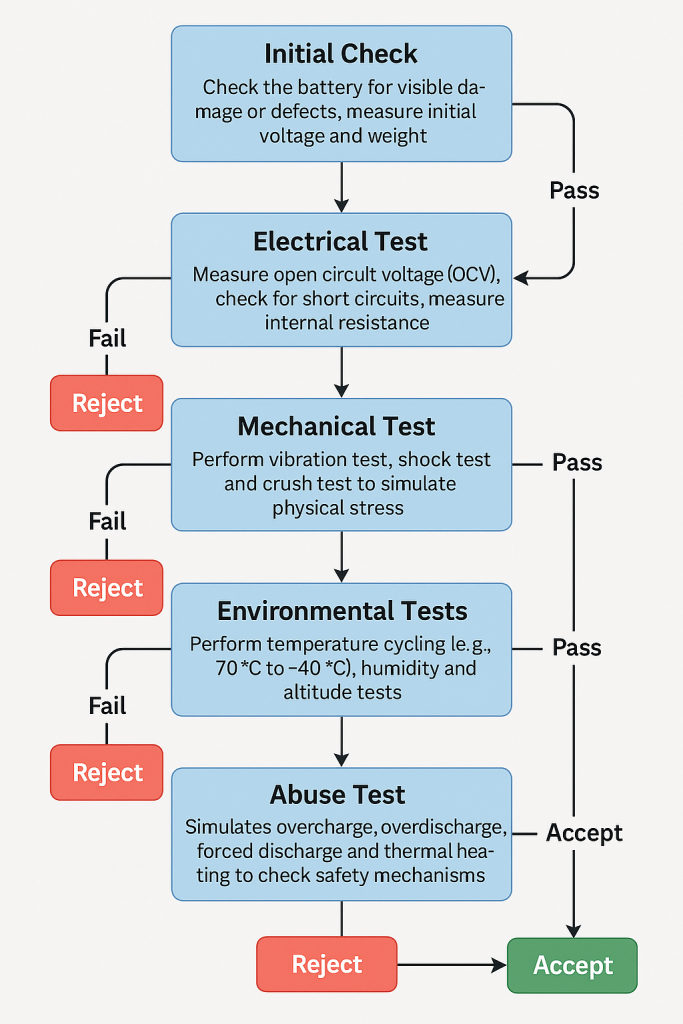These days, batteries and battery systems are used in consumer electronics, means of transportation, renewable energy systems, medical equipment, industrial tools and devices, military and aerospace applications, toys and gadgets, and recreational gear. All these applications are critical in one or the other way and, thus, it is highly needed that batteries operate safely in respective systems without exploding or damaging associated components. This requirement makes battery safety testing equipment valuable. These systems prevent hazards and mitigate potential risks including thermal runaway, leakage and contamination, short-circuiting, and explosions. In this article, we will focus on functioning/performance of battery safety testing equipment with special focus on its capability to prevent thermal runaway and explosions.
What is meant by Thermal Runaway and Explosion in a Battery?
While terminology of explosion is straightforward and indicates total destruction, it is important to understand thermal runaway for a battery. Thermal runaway happens when phenomenon of positive temperature feedback takes place. Once started, it is difficult to stop as it acts like a chain reaction. In such scenario, generated heat is higher than cooling through battery walls. Thermal runaway might occur during charging phase specifically when a battery is overcharged surpassing its maximum voltage or it is charged rapidly. External or internal short circuiting can also cause thermal anomalies. Extreme low or high temperatures can trigger thermal runaway. Manufacturing faults, excessive moisture content or humidity, and physical damage can also cause thermal runaway. In such condition, temperature of battery cell might go up to 500°C. At this point, battery might catch fire, and eventually explode damaging the whole system.
Why Battery Safety tests and Testing Equipment is Important?
Either it is about energy storage systems, or medical devices, safety testing of batteries is important which is conducted using battery safety testing equipment. An automated battery tester or automated EV battery tester might also entail a listing of safety tests.
Battery safety tests ensure safe operation and help identify any potential risks during function or rest mode. Safety tests analyze performance and stability of batteries under varying conditions like physical stress, temperature rise and drop, and load changes. Before deployment of batteries in any critical system or application, conducting these tests has become a critical step and one of evaluation criteria. Importance of safety tests lies in the following.
- Battery will operate safely in system without experiencing any thermal runaway or exploding along with other components or whole system.
- Tested system is more resilient and reliable than non-tested system.
- Battery complies with international safety standards like that of ISO, IEC, or FDA.
- Long-term performance goals are expected as potential degradation issues are observed and analyzed
- Safety of battery-based system keeps personnel, associated people, and animals safe. For example, battery used for medical devices operates inside body sometimes. Malfunctioning or thermal runaway of battery in such scenario might cost life.
- Compliance with safety standards makes a manufacturer more credible, boosts confidence in the product and helps a brand standout.
- It helps in allocation and utilization of resources (personnel as well as funds) in meaningful way as costly recalls and returns upon failures are reduced significantly.
- Analysis and interpretation of safety test results not only helps improve design of under-consideration battery technology, but it also helps researchers while they conduct research on new battery chemistries, test prototypes, think of new materials for electrodes or casing, design electronics, and so on.
Types of Tests Conducted By Battery Safety Testing Equipment
Before jumping onto exploring the role of safety tests to prevent thermal runaways and explosions, it is crucial that you fully understand battery safety tests conducted by a safety testing equipment or automated battery testing equipment. Here, categories of tests are mentioned and tests in respective categories are listed to present a holistic idea of battery safety.
Electrical Testing:
In electrical tests, electrical properties of batteries are assessed. Current, Voltage, and impedance are most important parameters in this regard. It is important to emphasize significance of electrical safety tests because most battery failures occur because of unnoticed mild shorts (an electrical fault) that might turn into full-blown disasters. To avoid such faults, fuses are placed which open when unusually higher current starts flowing. In a few cases, some fuses might open permanently rendering the battery inoperable. Most of the times, fuses reset and close back restarting the normal operation after servicing is done. Solid-state switches are also installed to give an extra layer of security to avoid electrical faults. Similarly, for all other kinds of electrical faults also, safety design features are incorporated.
Mechanical Testing:
Mechanical tests are performed on battery to access how it would behave if exposed to physical stress and know if its mechanical structure would be preserved or not. For example, if a vehicle experiences an accident, battery would experience an extreme physical shock which can cause leakage, explosion, or any other issue aggravating the situation. Batteries tested for mechanical stresses and assured to remain integrated in such scenarios might bring a sense of security and boost trust in overall product.
Environmental Testing:
Batteries installed in EVs, energy storage systems, medical devices, or toys might experience one or multiple environmental factors like vibrations, humidity, extreme low or higher temperatures, and so on. These might bring anomalies in functionality and even cause thermal runaways and explosions. Batteries tested against these environmental factors help update safety features, and design of battery. Moreover, assessment based on test helps manufacture prepare a detailed guideline for usage conditions and set limits for operation of targeted battery for any application. For example, manufacturer might mention that operating temperature range is ‘this’ to ‘this’ for vehicle equipped with this specific type of battery.
Abuse Testing:
Extreme scenarios like over charging, over discharging, and short circuiting are regarded as abuse conditions. In real-time also, battery might show such behavior leading to explosion and thermal runaway. Batteries tested against abuse behaviors are more reliable and suitable for more demanding applications.
How Battery Safety Tests Help Avoid Thermal Runaways and Explosions
In upper sections, we have discussed reasons of thermal runaways and then we have discussed types of tests conducted under the umbrella of safety testing. If analyzed and linked side-by-side, you can identify that each reason for potential failure is tested by battery’s safety testing equipment by subjecting battery to real-world conditions in controlled manner and then analyzing the behavior of that specific type of battery. After conducting the tests, manufacturers and design engineers become clear about product specifications, safety features, and required design changes to improve performance of battery in any unusual condition. For example, result of short-circuit safety test might turn out to be positive that respective fuses or solid switches opened and battery didn’t enter into thermal runaway, ignition and explosion situation. And if test result was not positive and battery ended up being in thermal runaway situation, it still gives design engineers an idea for up gradation of safety mechanism. Thus, these tests help boost performance of battery in unforeseen circumstances avoiding thermal runaways by taking appropriate action.
Similarly, all factors which might contribute to thermal runaways and explosions are listed, tests are conducted, results are compiled and analyzed, design changes are made, and then tests are conducted again. This way design improvements are made. Apart from generating recommendations regarding design changes to maximum possible extent, battery safety tests also help recognize suitable storage and operational conditions and limits so that no thermal runaways could take place.
Battery Safety Standards:
Battery safety standards involve rigorous testing and certification processes to ensure safe design, transportation, handling, storage, and operation of all kinds of batteries. Safety standards are formulated depending upon type of battery and its applications which is relevant to size also. Some of the notable safety standards are listed here.
- IEC 62133: This standard is for rechargeable lithium-ion batteries used in portable consumer electronic devices like tablets, cell phones, laptops, wristwatches, etc. This code covers various electrical, mechanical, and chemical safety tests.
- UL 4200A: This standard outlines tests and procedures for products equipped with button or coin cell batteries.
- UL 2271: This standard is for batteries used in light electric vehicles.
- UL 1989: This standard covers requirements for standby batteries placed in instruments, emergency lighting systems, or UPS (uninterruptible power supplies).
- UL/CSA/IEC 60065: These standards ensure the safety of audio and video equipment equipped with batteries.
Top Manufacturers for Battery Safety Testing Equipment:
Many companies have designed and manufactured battery testing equipment which might be partially or fully automated, equipped with application and interfaces to help control test procedure. One type of tester could perform multiple types of tests related with battery’s safety also. Moreover, their inbuilt testing system ensures that tests are performed in compliance with well-recognized international regulatory standards so product is more reliable. Here some manufacturers for battery testing equipment and their features or product ranges are mentioned.
Sinexcel RE
This Chinese brand has designed a large variety of battery testing equipment under the wide categories of 3C testing equipment, EV battery testing equipment series, battery module testing equipment series, and battery PACK testing equipment series. All these product series have the capability to perform multiple types of tests including those which are essential for battery safety testing like charging, discharging, harmonic analysis, and other electrical aspects. Its products are highly accurate with output measurement accuracy reaching 0.05%F.S. Sinexcel RE’s products are also very efficient when it comes to energy feedback. Its battery testing equipment are compatible with a wide range of battery sizes.
TECHMIZE
DC resistance is an important parameter to estimate health of battery and to assess if it would keep operating safely because this resistance is related to energy dissipation and heat generation. TECHMIZE has a large variety of DC resistance meters with basic accuracy to the tune of 0.01%. Test ranges for its products lie between 0.1uΩ to 110MΩ, 1uΩ to 2MΩ, and 10uΩ to 200kΩ. All of their DC resistance meters are equipped with digital display for ease of use. All of its products support RS232, USB HOST, USB device, and LAN. These devices also give the option to store all screen information on a U-disk.
SPEA
SPEA designs and manufactures automatic battery testing equipment which can perform holistic testing on battery modules and cells. SPEA claims that its product T100BTis a modular and innovative battery testing equipment. It can detect all possible defects of a battery cell or module including defected cell wiring, surface or geometrical anomalies, and out-of-specs performance. This product is very accurate for testing electrical parameters, and offers high configurability. This single device can perform thermal tests and geometrical tests along with electrical and optical tests.
QUALITEST
When you are considering to test your batteries as researcher, manufacturer or design engineer, battery tester is not the only thing to be considered. Qualitest has stepped-in to provide supporting accessories for battery testing. For battery safety testing, multiple products are needed to conduct the test successfully, accurately, and safely. These products include battery explosion proof temperature test chamber, temperature and altitude chamber, battery dry chamber, walk-in dust proof test chamber, EV electric vehicle test chillers, Battery Diaphragm Gas Permeability tester, precision constant high temperature oven, and handled LIBS analyzer. Its products are compatible with multiple standards including IE62133, UL 1642, and UN 38.3.
Conclusion
Safe operation of battery-based systems is very essential as it affects costs, lives, system standards, strategic planning for respective industry, and much more. To make sure that batteries of all types and sizes keep functioning without entering into thermal runaway mode or exploding, it is highly encouraged to test battery cells and modules for all possible risk factors. Battery safety testing equipment come in handy to fulfil this testing need. Different manufacturers have designed multiple devices to conduct safety tests on batteries. You can choose one considering your requirements like battery type, size, quantity of under-consideration batteries, and costs. This equipment will help you boost quality of your product and boost it to be more reliable and safe.If you would like to know more about the standard battery safety testing system, please contact us.



